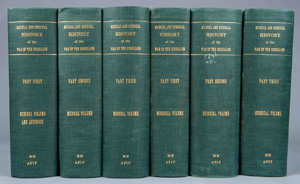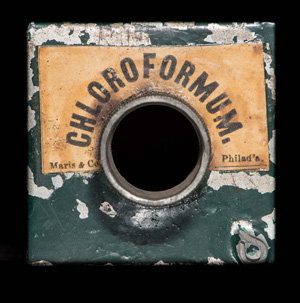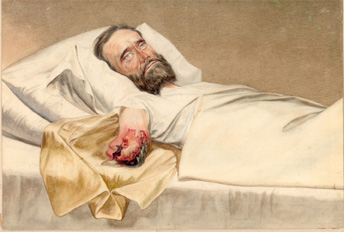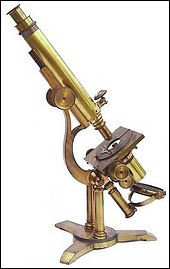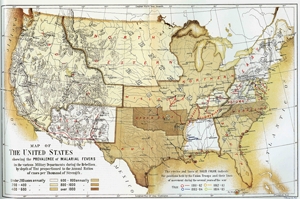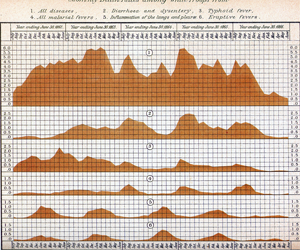An Extraordinary Enterprise: Medical Effects of the Civil War
The Army Medical Museum, nearly from the time of its founding in 1862, was engaged in an innovative effort to collect, collate and share the lessons of battlefield medicine during the course of the Civil War. The grandest effort of its kind to date and hardly eclipsed in the decades since, the six-volume "Medical and Surgical History of the War of the Rebellion" was the seminal work of the museum in the late 19th century.
"The Medical and Surgical History of the War of the Rebellion" represents one of the most extensive data collection efforts in the history of wartime medicine. Through complex stories and innovative graphics, "Medical and Surgical History" recounts an unprecedented effort to learn from the wounds and maladies of war.
"Medical and Surgical History" is replete with detailed case histories from surgeons in the field, and is illustrated with thousands of woodcuts, drawings and photographs documenting the nature of injury and attempts at treatment. In the parlance of today's military medical enterprise, "Medical and Surgical History" offers the "lessons learned" of battlefield medicine and hospital care from the Civil War. It stands today as a testament to the nature of scientific inquiry by the Army Medical Museum surgeons and curators of that day.
Concurrent with the temporary Lincoln exhibit, NMHM has installed a special exhibit featuring the "Medical and Surgical History." Objects on display include artifacts, specimens and images documented in the work, including a review of gunshot injuries, charts about the spread of disease and infection, and artifacts that chronicle the novel use of anaesthesia during the course of the war.
A review of the "Medical and Surgical History" from 1873 offers a testament to its value: "War has its horrors, and produces its miseries—our recent Civil War, in its consequences, will be felt, with a shudder, until the end of time—but it has its trophies, also—trophies which will serve to ameliorate distress and rob disease and disaster of many of their terrors. Of these, are such works as this; and the world, through time, looking over and beyond the smoke and blood of the battlefields on which they were gathered, will accept the results and be benefitted by the riper experience which is thus secured." (Gazette Hebdomadaire, 1873)
The "Medical and Surgical History" exhibit is open through at least 2015.
Selection of objects from the "Medical and Surgical History" exhibit:
Complete Set of the “Medical and Surgical History of the War of the Rebellion”
The contents in this six-volume set took 23 years to complete, weighed in at 56 pounds, and
numbered more than 6,000 pages. The Army Medical Museum shipped copies of MSHWR to universities,
libraries, professional societies, and major medical figures in the United States and Europe.
Letters of receipt convey their gratitude and “amazement” at the amount of labor involved in
preparing these volumes that were considered “historical testaments not only to the honor of the
profession of this country but of the country itself.”
(Otis Historical Archives, National Museum of Health and Medicine, Silver Spring, Md.)
(Disclosure: This image has been cropped to emphasize the subject.) (National Museum of Health
and Medicine photo by Matthew Breitbart/ Released)
Chloroform Tin
Chloroform played a major role in Civil War surgery and the section on anesthesia in the
“Medical and Surgical History” received critical acclaim for the complete and extraordinarily
interesting survey of its use. Of 8089 wartime injuries involving major operations chloroform
was used in 6784 cases, ether in 1305.
(M-660.00281, Historical Collection, National Museum of Health and Medicine)
(Disclosure: This image has been manipulated by using dodging and burning techniques. It has been
cropped to emphasize the subject.) (National Museum of Health and Medicine photo illustration by
Matthew Breitbart/ Released)
Private Milton E. Wallen, Co. C, 1st Kentucky Cavalry, was wounded July 4, 1863 at Richmond, VA.
(CWMI 98) (Otis Historical Archives, National Museum of Health and Medicine, Silver Spring, Md.)
Assistant Surgeon Joseph J. Woodward used this microscope (top) for his pioneering work in photomicrography,
which provided extraordinary insight into the physiological processes associated with various diseases.
(M-030.00390) (Historical Collection, National Museum of Health and Medicine)
The illustration (bottom) from Woodward’s “Report to the Surgeon General, of the United States Army, on the
Magnesium and Electric Lights, as Applied to Photo-Micrography,” (1870) demonstrates how a light source (A)
is concentrated on the lens of the microscope (B) and then projected on to a photographic plate (C).
(OHA 83) (Otis Historical Archives, National Museum of Health and Medicine, Silver Spring, Md.)
Graphic Distribution of Diseases and Death Rates
The map (top) demonstrates how rates of malarial fevers could vary widely from one geographical region to
another, with particularly strong differences between northern and southern states.
The diagram (bottom) illustrates how death rates from some diseases clearly followed a seasonal pattern.
(MSHWR, Part III, Medical Volume I, pp. 20 and 100) (Otis Historical Archives, National Museum of Health
and Medicine, Silver Spring, Md.)



